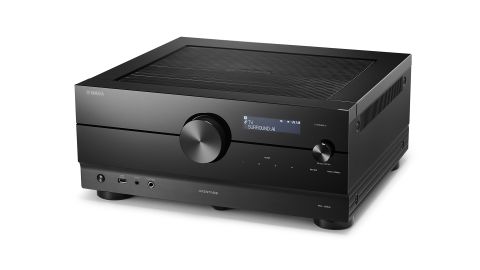For manufacturers trying to keep up with technology trends, the feeling of constantly playing catch-up must be acute. No sooner does a company release its latest and greatest piece of home entertainment kit than a new feature comes along and suddenly obsoletion beckons. When it comes to products such as AV receivers that have to link multiple devices, all with their own raft of constantly evolving specifications, things are even trickier.
As the hub of any home cinema, an AVR must be able to keep up with the ever-changing demands of video, sound, streaming and gaming technology, not to mention the NeverEnding Story-like tome of HDMI 2.1 protocols that provide the basis of their interface.
When Yamaha first announced its current Aventage range, in which the RX-A6A sits one notch below the flagship model, it was notable both for its benchmark-setting support of HDMI 2.1 with up to 40Gbps of bandwidth across all inputs and outputs and for the number of asterisks attached to its specifications, indicating technology that would eventually be added by way of future software updates.
This means that users who purchased the RX-A6A when it launched in 2021 had to patiently wait for firmware updates to unlock the capability for passthrough of uncompressed 4K@120Hz and 8K@60Hz signals as well as HDR10+ across its seven inputs and three outputs. Support for gaming features ALLM (Auto Low Latency mode) and VRR (Variable Refresh Rate) has also been added retrospectively, but there’s still no date for when QMS (Quick Media Switching) and QFT (Quick Frame Transport) will be added.
While this long road of delayed upgrades will have no doubt been frustrating for some, ultimately, we think it shouldn’t deter those considering one of the most precise sounding, well-specced, flexible and future-proofed AVRs that we’ve come across at this price point.
Price
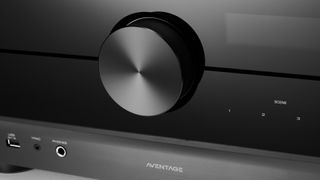
Costing £2299 / $2200 / AU$3699, the Yamaha RX-A6A supersedes 2019’s RX-A3080 and sits firmly in Denon AVC-X6700H territory. The Denon is a formidable What Hi-Fi? Award-winner that launched at £2299 / $2499 / AU$6190 and offers two more channels of amplification than the RX-A6A. Unlike the Yamaha, however, only one of its eight inputs and two of its three outputs are HDMI 2.1-certified (though all ports already support 2.1 gaming features such as VRR, ALLM, QMS and QFT).
Yamaha considers the RX-A6A to be the best-value AVR in its current line-up as it boasts a near-identical feature set to the flagship RX-A8A (£3299 / $3000 / AU$6299) for considerably less outlay, especially when you consider that it can now be found for much less than its launch price. Most of the differences are subtle and internal: the A6A doesn't have the same separation between the transformer and power stages, extra-large custom block capacitors or the same level of structural damping as the A8A. Additionally, while the A8A has dual 32-bit/384kHz ESS Hyperstream ES9026PRO DACs, the A6A only has one to handle the main channels, while an ES9007S DAC takes care of the ambient channels.
Build
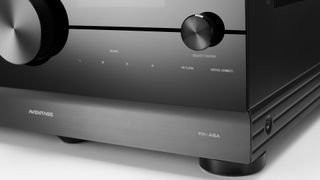
Outwardly, all the AVRs in the current Aventage range share the same glossy, monolithic design with a sleek, uncluttered front panel that sports a large central volume control with an input select dial and large text LCD display. The screen doesn’t display artwork in the way that the Arcam AVR5's does, but it can be customised to show the playback information of most interest to you.
Yamaha has redesigned the front panel to be more rigid than in previous generations, so in terms of connectivity, you’ll only find a 6.3mm headphone jack, a USB-A port with 5V charging, and a mini-jack to plug in the microphone for Yamaha’s YPAO auto-calibration.
The remote control, however, is far from minimalist in its layout but benefits from being both backlit and tactile, helping you get to grips with its extensive, mainly useful shortcuts.
Features
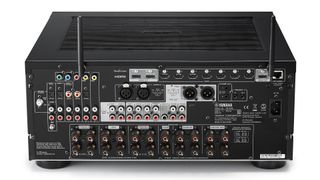
Yamaha is nothing if not comprehensive when it comes to offering options to customise its products, and the A6A outputs a full-screen menu so vast you could curl up with it for about a week. Each page includes practical explanations for each parameter, and there are options to tweak to your heart's content, with everything from each HDMI port’s Jitter PLL Mode to the steepness of the DAC’s roll-off curve accessible to the curious user.
This granular level of detail could be off-putting for many, but we find the exhaustive menu a helpful guide to the A6A’s features, encouraging experimentation. When combined with Yamaha's step-by-step YPAO automated room optimisation process, which uses an included microphone and stand that resembles a three-pointed boomerang, it's apparent that this system doesn’t necessarily require a professional install – though we’d certainly recommend that you manually double-check YPAO’s measurements.
Many system settings can also be accessed from an external device on the same network using the AVR’s IP or the Yamaha MusicCast app. The app allows for streaming of hi-res and lossless music formats, including Apple Lossless (ALAC) up to 96 kHz, WAV, FLAC and AIFF up to 192kHz, as well as integrated playback from services including Spotify, Tidal, Qobuz and Deezer.
For more casting options, there’s also AirPlay 2 and Bluetooth 4.2 (SBC / AAC) on board, as well as Google Assistant and Alexa compatibility for voice control and a DAB+ and FM/AM tuner for good measure. The A6A is particularly generous when it comes to its hardwired audio inputs, too, with three optical, two coaxial and five analogue inputs including, unusually, XLR sockets, plus another one dedicated to phono.
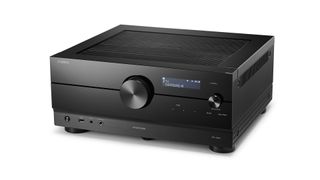
HDMI inputs 7
HDMI outputs 3 (including eARC)
HDMI 2.1 Yes inc VRR, ALLM
Processing 11.2 channels
Amplification 9 channels
Power 150W (per channel) with two channels driven
HDR formats HDR10+, HLG, Dolby Vision
Audio formats Dolby Atmos, Dolby Atmos Height Virtualizer, Dolby TrueHD, Dolby Digital Plus, Dolby Surround, DTS:X, DTS-HD Master Audio, Auro 3D
Streaming Ethernet, wi-fi, Bluetooth (SBC / AAC), Airplay 2, Yamaha MusicCast, Spotify Connect
There are terminals for 11 channels, but the A6A has amplifiers for just 9. For those looking to put together a 7.2.4 system, the A6A offers line-level outputs for either the main left-right pair or the rear Atmos speakers. Yamaha doesn’t release figures for the amp's power when all channels are driven, but its two-channel output of 150W (8 ohms) is the same as that of the flagship A8A.
Like the rest of the Aventage range, the A6A can also power a pair of speakers in another room, even if 9 speakers are already connected in the main room. It does this using a feature called Intelligent Power Amp Assign, which diverts power from two of the speakers in the main room when Zone 2 is activated.
Support for immersive formats includes Dolby Atmos, DTS:X and Auro-3D, and upmixing technology such as Dolby Surround and DTS Neural:X. Meanwhile, there are plenty of options for those who don’t have the speakers for a complete surround system, including Dolby Atmos height virtualiser, Virtual Presence Speaker and Virtual Surround Back Speaker. Having a full array of physical speakers will clearly give you the best performance, but some will appreciate having these virtualisation options.
In a nod to Yamaha's musical and pro audio roots, the A6A also includes the company's Cinema DSP HD3 processing, which aims to recreate 24 real-life spaces such as reverberant concert halls and arenas in your living room. It's a feature that you can have a lot of fun playing with but can be a bit synthetic sounding and probably, for most people, will be superfluous.
More useful will be Surround: AI which adjusts the levels of dialogue, music and effects in each scene to help maintain clarity. We find that this mainly helps preserve speech in louder scenes but leave it off for most of our testing, the majority of which is done in pure direct mode, bypassing YPAO EQ adjustments.
Sound
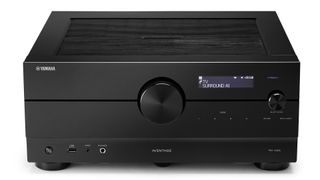
We start with A Quiet Place in Dolby Atmos and are quickly struck by the clean, crisp and dynamic performance the A6A puts in. Every accidental noise made by Emily Blunt as she attempts to give birth in complete silence is precise and well-etched, with each sudden movement of the monster proving this is an equally capable AVR when delivering weighty impactful sounds.
Similar to Yamaha’s more affordable A2A, the A6A has a spacious presentation but with more authority, keeping everything balanced and preventing things from sounding overly diffused. Switching to Dune, also in Atmos, we begin with the scene in which Timothée Chalamet and Josh Brolin spar, and the hard, reflective surfaces of the room are well recreated with excellent directionality as the two prowl around the space, and each subsequent shift in location is emphatically felt.
High frequencies are perhaps where the A6A does its best work, and this helps in the delivery of its expansive and detailed sound stage, from the textured rainfall to the swirling whispers of the Bene Gesserit. Depending on your taste, some may find the top end a touch insistent, and while we feel it's well proportioned, adding excitement and sparkle, generally we do also feel the need to notch down the overall volume compared to the Denon AVR-X6700H. Because of this, we recommend taking a bit of care when choosing a speaker package to partner the Yamaha.
The character of the Denon is a bit deeper and a touch more fluid compared to the transparency of the A6A, and when listening to music the Denon gives the impression of being slightly warmer and less analytical. Streaming Hard Sun by Eddie Vedder, there's more of a Time Team epicness to the thunderous drums and proximity with Vedder’s raw vocal with the 6700. But the A6A is undoubtedly the quicker, more rhythmic performer with nimble, sharp transients accentuating the delicacy of each picked guitar string with impeccable timing.
Verdict
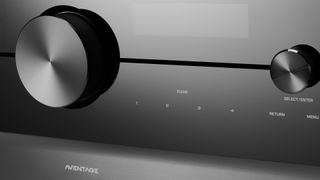
Good things and HDMI functionality come to those who wait, and despite the delays the Yamaha RX-A6A is still an impressively specced amp. With its exhaustive feature set ranging from the complex to the whimsical, the A6A is very much the 'choose-your-own adventure' of AVRs, with a completist approach to almost every aspect of its configuration.
All that technology is backed up by an impressive sonic performance with sparklingly precise transients, crisp dialogue and a spacious, well-balanced soundstage. The A6A is one of the most responsive, clean and dynamic-sounding AVRs we’ve heard at this price.
SCORES
- Sound 5
- Build 5
- Features 5
MORE:
Read our review of the Denon AVC-X6700H
Also consider the Arcam AVR5
Read our Denon AVC-X3700H review
These are the best AV receivers: brilliant home cinema amplifiers
